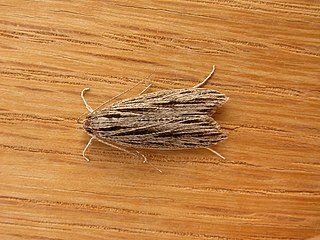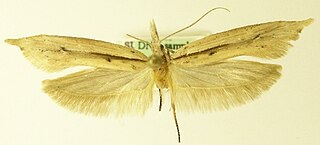Hylograptis is a monotypic moth genus in the family Gelechiidae. Its only species, Hylograptis thryptica, is found in Australia and New Guinea, where it has been recorded from Woodlark Island and Sariba Island. Both the genus and the species were first described by Edward Meyrick in 1910.
Smenodoca is a genus of moth in the family Gelechiidae. It contains only one species, Smenodoca erebenna, which is found in Australia, where it has been recorded from New South Wales, Victoria and Western Australia.
Tanycyttara is a monotypic genus of Australian moths in the family Gelechiidae containing the sole species Tanycyttara xanthomochla, which is found in Australia, where it has been recorded from Queensland.

Leistarcha scitissimella is a moth of the family Xyloryctidae. It is found in Australia, where it has been recorded from the Australian Capital Territory, New South Wales and Queensland.

Eupselia satrapella is a species of moth of the family Depressariidae. It is found in Australia, where it has been recorded from Queensland, New South Wales and the Australian Capital Territory.

Ypsolopha mucronella is a moth of the family Ypsolophidae. It is found from Europe, through Siberia to Japan and in Asia Minor.

Harmologa oblongana is a species of moth of the family Tortricidae. It is found in New Zealand.
Ardozyga compsochroa is a species of moth in the family Gelechiidae. It was described by Edward Meyrick in 1904. It is found in Australia, where it has been recorded from South Australia and New South Wales.
Ardozyga phasianis is a species of moth in the family Gelechiidae. It was described by Edward Meyrick in 1904. It is found in Australia, where it has been recorded from New South Wales, Victoria and Tasmania.
Ardozyga stratifera, the striped ardozyga moth, is a species of moth in the family Gelechiidae. It was described by Edward Meyrick in 1904. It is found in Australia, where it has been recorded from Queensland, New South Wales, Victoria, Tasmania, South Australia and Western Australia.
Ardozyga penthicodes is a species of moth in the family Gelechiidae. It was described by Edward Meyrick in 1921. It is found in Australia, where it has been recorded from southern Queensland.
Ardozyga subnexella is a species of moth in the family Gelechiidae. It was described by Francis Walker in 1864. It is found in Australia, where it has been recorded from Queensland and New South Wales.
Ardozyga haemaspila is a species of moth in the family Gelechiidae. It was described by Oswald Bertram Lower in 1894. It is found in Australia, where it has been recorded from New South Wales and South Australia.
Ardozyga orthanotos is a species of moth in the family Gelechiidae. It was described by Oswald Bertram Lower in 1900. It is found in Australia, where it has been recorded from Victoria.
Trichloma is a moth genus in the subfamily Autostichinae. It contains the species Trichloma asbolophora, which is found in Australia, where it has been recorded from Victoria.
Bida is a monotypic moth genus in the family Xyloryctidae described by Francis Walker in 1864. Its only species, Bida radiosella, described by the same author one year earlier, is found in Australia, where it has been recorded from New South Wales, South Australia, Tasmania, Victoria and Western Australia.
Copidoris dimorpha is a moth in the family Xyloryctidae, and the only species in the genus Copidoris. The genus and species were both described by Edward Meyrick in 1907 and are found in Australia, where it has been recorded from New South Wales, Queensland, Victoria and Western Australia.
Xerocrates is a monotypic moth genus in the family Xyloryctidae. Its only species, Xerocrates proleuca, is found in Australia, where it has been recorded from South Australia, Victoria and Western Australia. Both the genus and species were first described by Edward Meyrick in 1890.
Zaphanaula hemileuca is a moth in the family Xyloryctidae, and the only species in the genus Zaphanaula. It was described by Turner in 1896. It is found in Australia, where it has been recorded from Queensland.

Antipterna euanthes is a species of moth in the family Oecophoridae, first described by Edward Meyrick in 1885 as Ocystola euanthes, with the female lectotype being found in the Wirrabara Forest, South Australia. It appears to be a moth endemic to Australia and in addition to South Australia is also found in Victoria, New South Wales, and Queensland.




